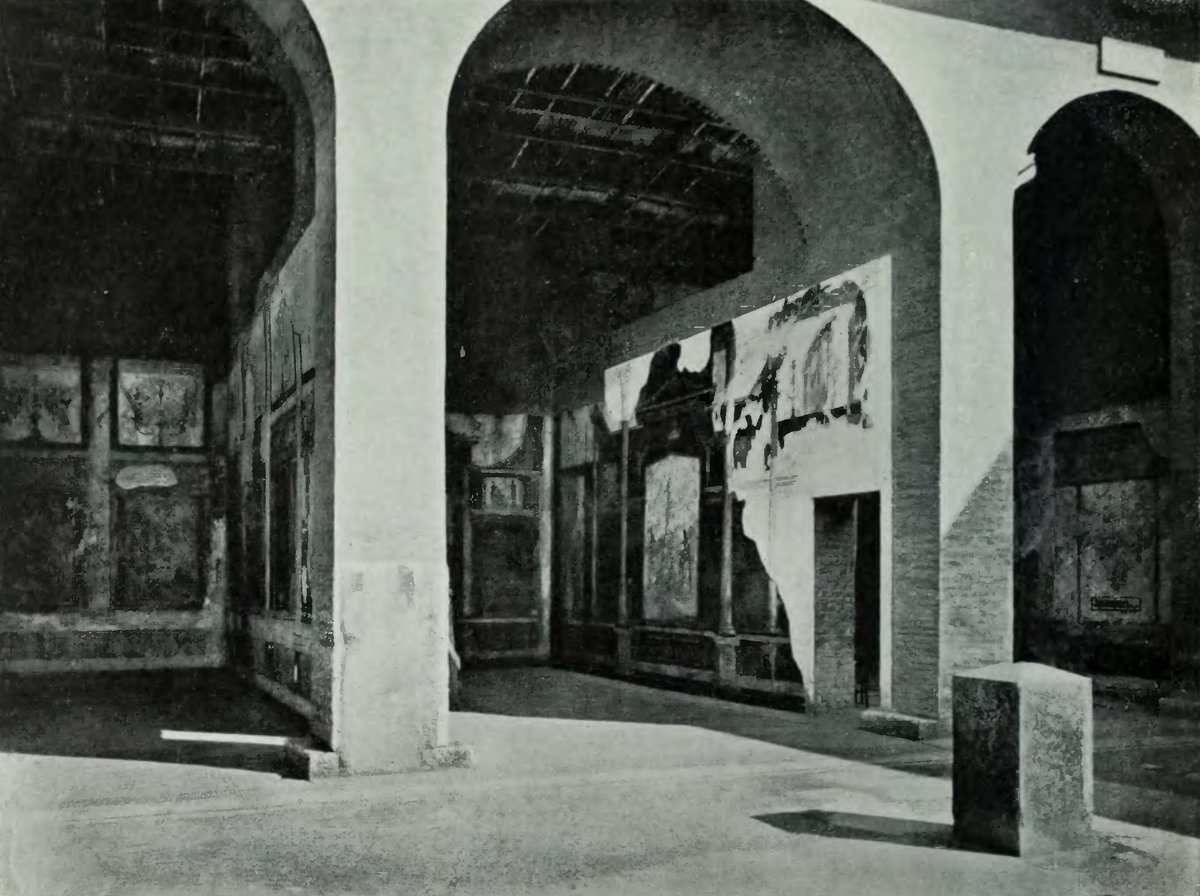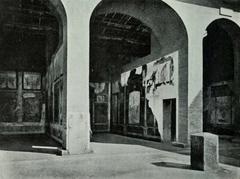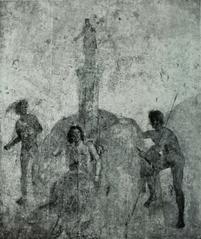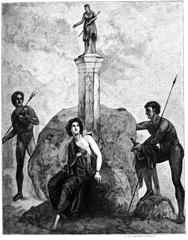
House of Livia: Visiting Hours, Tickets, and Historical Site Guide in Rome
Date: 15/06/2025
Introduction
The House of Livia, nestled on Rome’s storied Palatine Hill, stands as an enduring symbol of ancient Roman domestic life and Augustan political power. Traditionally linked to Livia Drusilla, wife of Emperor Augustus, this aristocratic residence is renowned for its refined architectural style and some of the finest surviving examples of Second Style Roman frescoes. Recent restoration efforts and the introduction of multimedia visitor experiences have further enhanced its significance, making the House of Livia a must-see destination among Rome’s archaeological landmarks. This comprehensive guide provides all the information you need for a memorable visit—covering historical context, visiting hours, ticketing, accessibility, conservation, and travel tips—so you can fully immerse yourself in the world of imperial Rome (Italy’s Best Rome; Madain Project; Finestre sull’Arte; Turismo Roma).
Table of Contents
- Introduction
- Historical Context and Origins
- Architecture and Layout
- Artistic Highlights: Frescoes & Mosaics
- Livia Drusilla: Influence and Legacy
- Discovery, Restoration, and Conservation
- Visitor Information: Hours, Tickets, Accessibility
- Travel Tips and Nearby Attractions
- FAQs
- Conclusion
- Sources
Historical Context and Origins
Set on the prestigious Palatine Hill, the House of Livia (Domus Liviae) was the residence of Livia Drusilla, the powerful wife of Augustus, Rome’s first emperor. Its proximity to the legendary Hut of Romulus was a deliberate political statement by Augustus, linking his regime to Rome’s mythical origins and reinforcing his legitimacy (Italy’s Best Rome). The Palatine was already a symbol of aristocratic status by the late first century BCE, and Augustus’s choice to reside in a relatively modest existing home, instead of building anew, showcased his publicized adherence to traditional Roman virtues.
Architecture and Layout
The House of Livia is a refined example of elite Roman domestic architecture, notable for its architectural restraint and elegance (Madain Project; Turismo Roma). The residence is organized around a rectangular atrium, with three main rooms on the lower accessible level. The entrance corridor features a geometric black-and-white mosaic, leading into the modest yet richly decorated atrium.
The central tablinum (reception room) and two side rooms were adorned with elaborate frescoes and mosaic floors. Advanced amenities typical of Rome’s elite are present, such as a sophisticated water supply system—evidenced by a lead pipe inscribed with “IVLIA AVGVSTA,” Livia’s imperial name (Wanted in Rome).
Artistic Highlights: Frescoes & Mosaics
The House of Livia is celebrated for its Second Pompeian Style frescoes, dating to around 30 BCE (Following Hadrian Photography). These paintings create illusionistic spaces, dissolving walls into vistas of architecture, myth, and landscape. The tablinum features mythological scenes, including “Io guarded by Argos and Mercury,” while the corridor displays trompe-l’oeil motifs with sphinxes and candelabra (Turismo Roma). The side rooms’ frescoes show garlands, fruit festoons, and garden imagery, symbolizing fertility and imperial virtues.
The preservation of these artworks is partly due to the protective circumstances of the house’s collapse, which shielded the paintings until their rediscovery. Mosaic floors throughout are simple, balancing the vibrancy of the wall art.
Livia Drusilla: Influence and Legacy
Livia Drusilla (58 BCE – 29 CE) was a key figure in the early Roman Empire, shaping political and social life. Her residence was as much a stage for imperial image-making as a private home. After Augustus’s death, Livia was honored as “Iulia Augusta,” and her legacy was immortalized in literature and art. The House of Livia thus stands as a testament not only to Roman artistry but also to the influence of imperial women in shaping Rome’s identity (Italy’s Best Rome).
Discovery, Restoration, and Conservation
First excavated in the 19th century, the House of Livia underwent major restoration in the late 20th and early 21st centuries. The latest restoration, completed in July 2024, included state-of-the-art cleaning, structural stabilization, and microclimate control to preserve the delicate frescoes (Finestre sull’Arte).
A major innovation is the multimedia visitor experience: rooms are illuminated in rotation, with narrative audio guides and lightmapping technology explaining decorative themes and drawing attention to key details. This approach both protects the artworks and offers deeper engagement for visitors.
Visitor Information: Hours, Tickets, Accessibility
Opening Hours
- March 31 – September 30: 9:00 am – 7:15 pm (last entry 6:15 pm)
- October 1 – October 26: 9:00 am – 6:30 pm
- October 27 – December 31: 9:00 am – 4:30 pm
- Closed: Tuesdays, January 1, December 25
Check for updates before your visit (Turismo Roma; Rome Tourist’s Palatine Hill guide).
Tickets
Access is included with the combined Colosseum, Roman Forum, and Palatine Hill ticket. For entry to special sites such as the House of Livia, the “Full Experience” or “S.U.P.E.R.” ticket is required (Earth Trekkers).
- Adult: €24 (“Full Experience” ticket, valid 48 hours)
- Reduced (EU 18–25): €2
- Free: Under 18, first Sunday of each month (note: House of Livia may be closed on free days to protect the site)
Purchase in advance via the official Colosseum Archaeological Park website.
Accessibility
Due to ancient terrain and narrow corridors, accessibility is limited. Some accommodations exist, but visitors with mobility challenges should contact the site in advance (Turismo Roma).
Travel Tips and Nearby Attractions
- Book tickets ahead to secure your preferred time slot.
- Arrive early or late afternoon to avoid crowds and heat, especially in peak months like June.
- Wear comfortable shoes for uneven surfaces.
- Photography is allowed without flash or tripods.
- Guided tours are highly recommended for in-depth context.
- Combine your visit with the House of Augustus, Roman Forum, and Palatine Museum for a full historical experience.
Amenities
- Restrooms and water fountains are available near main entrances.
- No cafés on site; bring water and snacks.
- Gift shops sell books, maps, and souvenirs.
Frequently Asked Questions (FAQs)
Q: What are the House of Livia visiting hours?
A: Hours vary by season; typically 9:00 am to early evening, closed Tuesdays and major holidays. Check official sources for the latest updates.
Q: How do I get tickets?
A: Tickets are part of the combined Colosseum, Roman Forum, and Palatine Hill entry. Purchase online or at designated ticket offices.
Q: Is the House of Livia accessible?
A: Accessibility is limited due to ancient infrastructure; check in advance for current accommodations.
Q: Are guided tours available?
A: Yes, expert-led tours are offered and recommended for a richer experience.
Q: Can I take photographs inside?
A: Yes, but no flash or tripods to protect the frescoes.
Conclusion
The House of Livia is a highlight of Rome’s archaeological landscape, offering a rare glimpse into the daily life, art, and power dynamics of the imperial family during the Augustan era. Its recent restoration and innovative visitor experience make it more accessible and engaging than ever. Plan your visit with care—considering opening hours, ticket options, and accessibility—and enrich your journey by exploring related sites on Palatine Hill. For updates and guided audio tours, download the Audiala app and consult official resources before your trip.
Sources
- Italy’s Best Rome
- Madain Project
- Finestre sull’Arte
- Turismo Roma
- Wanted in Rome
- Following Hadrian Photography
- Earth Trekkers
- Rome Tourist’s Palatine Hill guide
- Official Colosseum Archaeological Park website
- Visit-Colosseum-Rome




















































































































































































































































